brakes PEUGEOT 3008 2014 Owners Manual
[x] Cancel search | Manufacturer: PEUGEOT, Model Year: 2014, Model line: 3008, Model: PEUGEOT 3008 2014Pages: 389, PDF Size: 22.92 MB
Page 144 of 389
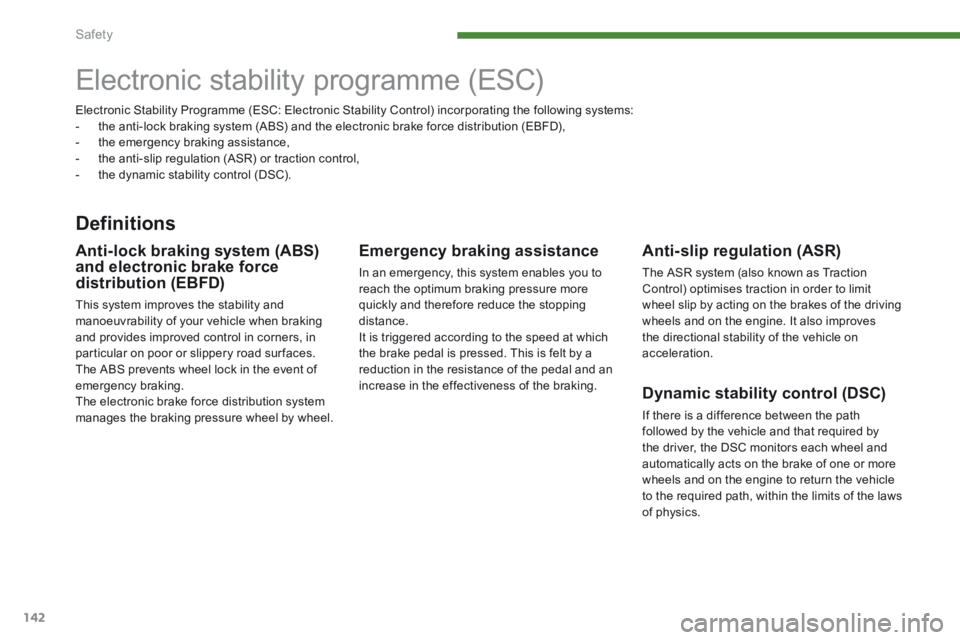
Safety
142
Electronic stability programme (ESC)
Definitions
Anti-slip regulation (ASR)
The ASR system (also known as Traction Control) optimises traction in order to limit wheel slip by acting on the brakes of the driving wheels and on the engine. It also improves the directional stability of the vehicle on acceleration.
Dynamic stability control (DSC)
If there is a difference between the path followed by the vehicle and that required by the driver, the DSC monitors each wheel and automatically acts on the brake of one or more wheels and on the engine to return the vehicle to the required path, within the limits of the laws of physics.
Emergency braking assistance
In an emergency, this system enables you to reach the optimum braking pressure more quickly and therefore reduce the stopping distance. It is triggered according to the speed at which the brake pedal is pressed. This is felt by a reduction in the resistance of the pedal and an increase in the effectiveness of the braking.
Anti-lock braking system (ABS) and electronic brake force distribution (EBFD)
This system improves the stability and manoeuvrability of your vehicle when braking and provides improved control in corners, in particular on poor or slippery road sur faces. The ABS prevents wheel lock in the event of emergency braking. The electronic brake force distribution system manages the braking pressure wheel by wheel.
Electronic Stability Programme (ESC: Electronic Stability Control) incorporating the following systems: - the anti-lock braking system (ABS) and the electronic brake force distribution (EBFD), - the emergency braking assistance, - the anti-slip regulation (ASR) or traction control, - the dynamic stability control (DSC).
Page 145 of 389
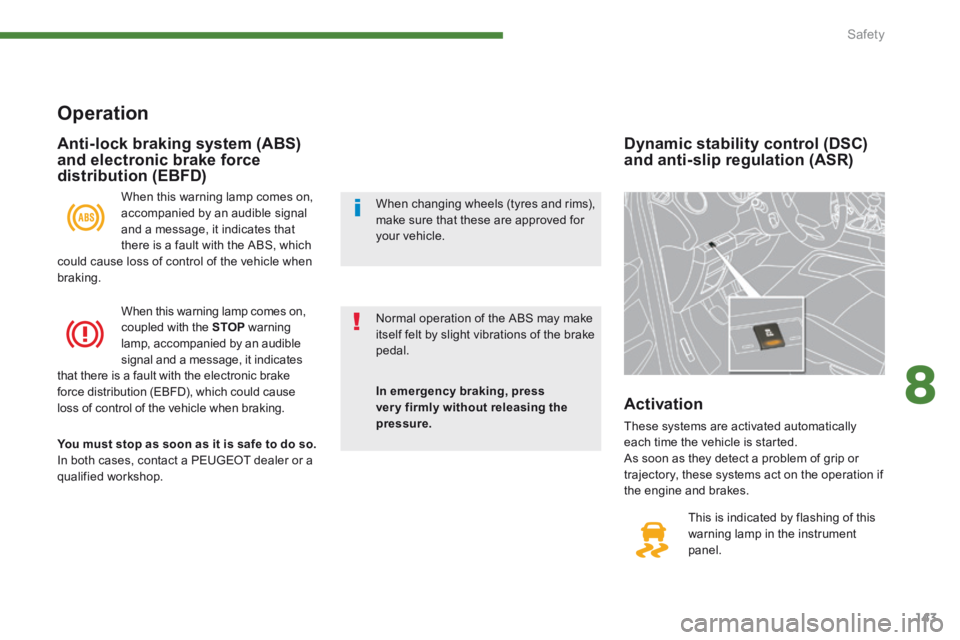
8
Safety143
Dynamic stability control (DSC) and anti-slip regulation (ASR)
This is indicated by flashing of this warning lamp in the instrument panel.
Activation
These systems are activated automatically
each time the vehicle is started. As soon as they detect a problem of grip or trajectory, these systems act on the operation if the engine and brakes.
Operation
When this warning lamp comes on, accompanied by an audible signal and a message, it indicates that there is a fault with the ABS, which could cause loss of control of the vehicle when braking.
When this warning lamp comes on, coupled with the STOP warning lamp, accompanied by an audible signal and a message, it indicates that there is a fault with the electronic brake force distribution (EBFD), which could cause loss of control of the vehicle when braking.
You must stop as soon as it is safe to do so. In both cases, contact a PEUGEOT dealer or a qualified workshop.
Anti-lock braking system (ABS) and electronic brake force distribution (EBFD)
In emergency braking, press very firmly without releasing the pressure.
Normal operation of the ABS may make itself felt by slight vibrations of the brake pedal.
When changing wheels (tyres and rims), make sure that these are approved for your vehicle.
Page 146 of 389
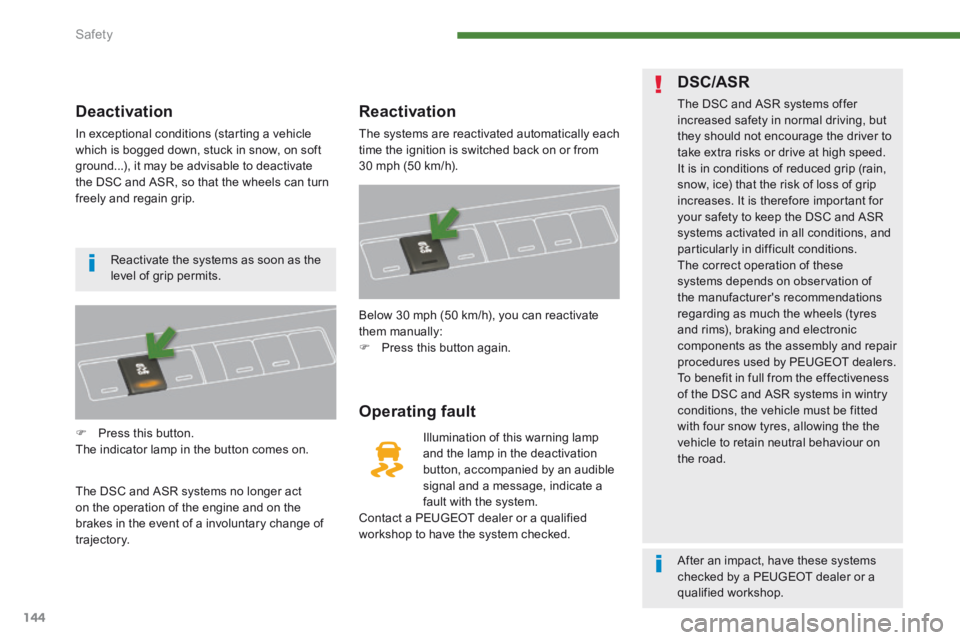
Safety
144
Deactivation
In exceptional conditions (starting a vehicle which is bogged down, stuck in snow, on soft ground...), it may be advisable to deactivate the DSC and ASR, so that the wheels can turn freely and regain grip.
Press this button. The indicator lamp in the button comes on.
The DSC and ASR systems no longer act on the operation of the engine and on the brakes in the event of a involuntary change of trajectory.
Reactivation
The systems are reactivated automatically each time the ignition is switched back on or from 30 mph (50 km/h).
Operating fault
Illumination of this warning lamp and the lamp in the deactivation button, accompanied by an audible signal and a message, indicate a fault with the system. Contact a PEUGEOT dealer or a qualified workshop to have the system checked.
Below 30 mph (50 km/h), you can reactivate them manually: Press this button again.
DSC/ASR
The DSC and ASR systems offer increased safety in normal driving, but they should not encourage the driver to take extra risks or drive at high speed. It is in conditions of reduced grip (rain, snow, ice) that the risk of loss of grip increases. It is therefore important for your safety to keep the DSC and ASR systems activated in all conditions, and particularly in difficult conditions. The correct operation of these systems depends on observation of the manufacturer's recommendations regarding as much the wheels (tyres and rims), braking and electronic components as the assembly and repair procedures used by PEUGEOT dealers. To benefit in full from the effectiveness of the DSC and ASR systems in wintry conditions, the vehicle must be fitted with four snow tyres, allowing the the vehicle to retain neutral behaviour on the road.
Reactivate the systems as soon as the level of grip permits.
After an impact, have these systems checked by a PEUGEOT dealer or a qualified workshop.
Page 178 of 389
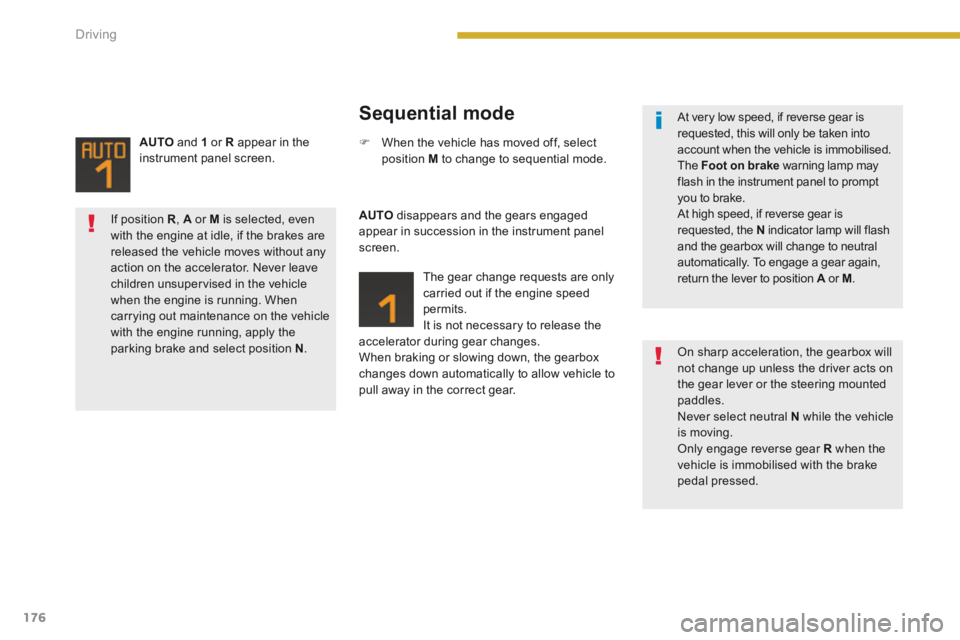
176Driving
AUTO and 1 or R appear in the instrument panel screen.
Sequential mode
AUTO disappears and the gears engaged
appear in succession in the instrument panel screen.
The gear change requests are only carried out if the engine speed permits. It is not necessary to release the accelerator during gear changes. When braking or slowing down, the gearbox changes down automatically to allow vehicle to pull away in the correct gear.
When the vehicle has moved off, select position M to change to sequential mode.
If position R , A or M is selected, even
with the engine at idle, if the brakes are released the vehicle moves without any action on the accelerator. Never leave children unsupervised in the vehicle when the engine is running. When carrying out maintenance on the vehicle with the engine running, apply the parking brake and select position N . On sharp acceleration, the gearbox will not change up unless the driver acts on the gear lever or the steering mounted paddles. Never select neutral N while the vehicle is moving. Only engage reverse gear R when the vehicle is immobilised with the brake pedal pressed.
At very low speed, if reverse gear is requested, this will only be taken into account when the vehicle is immobilised. The Foot on brake warning lamp may flash in the instrument panel to prompt you to brake. At high speed, if reverse gear is requested, the N indicator lamp will flash and the gearbox will change to neutral automatically. To engage a gear again, return the lever to position A or A or AM .
Page 182 of 389
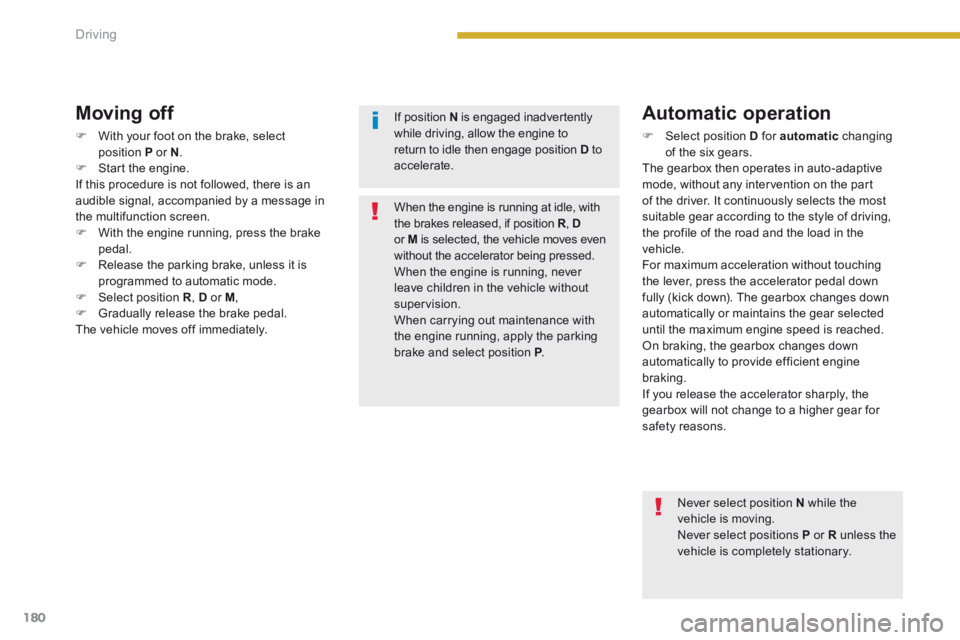
180Driving
Moving off
With your foot on the brake, select position P or N . Start the engine. If this procedure is not followed, there is an audible signal, accompanied by a message in the multifunction screen. With the engine running, press the brake pedal. Release the parking brake, unless it is programmed to automatic mode. Select position R , D or M , Gradually release the brake pedal. The vehicle moves off immediately.
Automatic operation
Select position D for automatic changing of the six gears. The gearbox then operates in auto-adaptive mode, without any intervention on the part of the driver. It continuously selects the most suitable gear according to the style of driving, the profile of the road and the load in the vehicle. For maximum acceleration without touching the lever, press the accelerator pedal down fully (kick down). The gearbox changes down automatically or maintains the gear selected until the maximum engine speed is reached. On braking, the gearbox changes down automatically to provide efficient engine braking. If you release the accelerator sharply, the gearbox will not change to a higher gear for safety reasons.
When the engine is running at idle, with
the brakes released, if position R , D or M is selected, the vehicle moves even without the accelerator being pressed. When the engine is running, never leave children in the vehicle without supervision. When carrying out maintenance with the engine running, apply the parking brake and select position P . P . P
If position N is engaged inadvertently while driving, allow the engine to return to idle then engage position D to accelerate.
Never select position N while the vehicle is moving. Never select positions P or R unless the vehicle is completely stationary.
Page 202 of 389

Checks
200
Brake disc wear
Brake pads
Brake wear depends on the style of driving, particularly in the case of vehicles used in town, over short distances. It may be necessary to have the condition of the brakes checked, even between vehicle services. Unless there is a leak in the circuit, a drop in the brake fluid level indicates that the brake pads are worn.
For information on checking brake disc wear, contact a PEUGEOT dealer or a qualified workshop.
Manual gearbox
The gearbox does not require any maintenance (no oil change). Refer to the warranty and maintenance record for the details of the level checking interval for this component.
Electronic gearbox
The gearbox does not require any maintenance (no oil change). Refer to the warranty and maintenance record for details of the checking interval for this component.
Automatic gearbox
The gearbox does not require any maintenance (no oil change). Refer to the warranty and maintenance record for details of the level checking interval for this component.
This system does not require any routine servicing. However, in the event of a problem, have the system checked by a PEUGEOT dealer or a qualified workshop.
Electric parking brake
Only use products recommended by PEUGEOT or products of equivalent quality and specification. In order to optimise the operation of units as important as those in the braking system, PEUGEOT selects and offers very specific products. After washing the vehicle, dampness, or in wintry conditions, ice can form on the brake discs and pads: braking efficiency may be reduced. Make light brake applications to dry and defrost the brakes.
For more information, refer to the "Electric parking brake - Operating faults" section.
Page 236 of 389

Practical information
234
Towing your vehicle
On the front bumper, unclip the cover by pressing at the bottom. Screw the towing eye in fully. Install the towing bar. Switch on the hazard warning lamps on the towed vehicle.
On the rear bumper, unclip the cover by pressing at the bottom. Screw the towing eye in fully. Install the towing bar. Switch on the hazard warning lamps on the
towed vehicle.
Towing another vehicle
Put the gear lever into neutral (position N for an electronic or automatic gearbox). Failure to follow this instruction could lead to damage to certain components (brakes, transmission, ...) and the absence of braking assistance on
restarting the engine.
General recommendations
Observe the legislation in force in your c o unt r y. Ensure that the weight of the towing vehicle is higher than that of the towed vehicle. The driver must remain at the wheel of the towed vehicle and must have a valid driving licence. When towing a vehicle with all four wheels on the ground, always use an approved towing bar; rope and straps are prohibited. When towing a vehicle with the engine off, there is no longer any power assistance for braking or steering.
In the following cases, you must always call on a professional recovery service: - vehicle broken down on a motor way or fast road, - 4 wheel drive vehicle, - when it is not possible to put the gearbox into neutral, unlock the steering, or release the parking brake, - towing with only two wheels on the
ground, - where there is no approved towing bar available...
Page 238 of 389
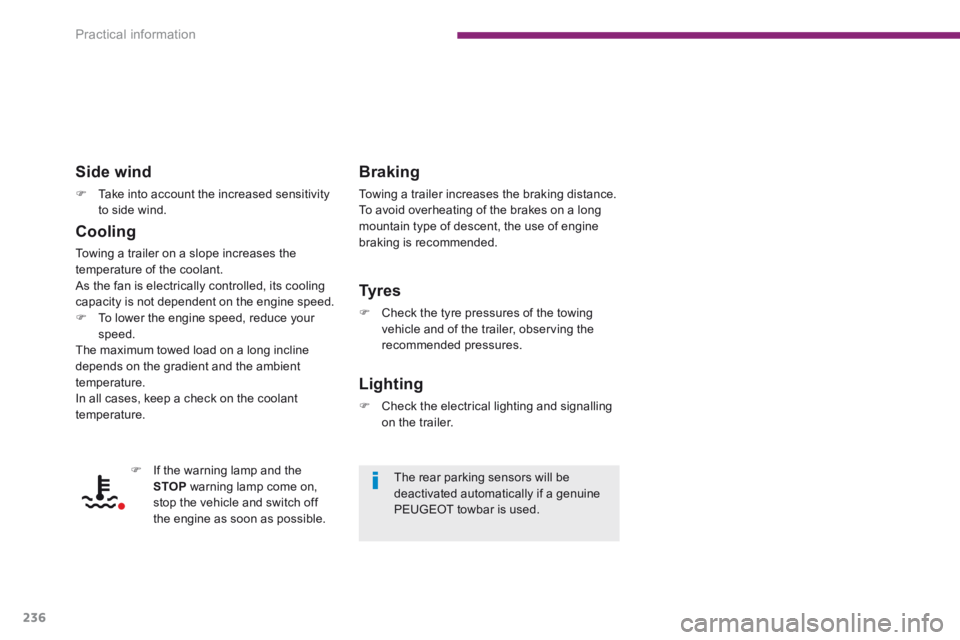
Practical information
236
Side wind
Take into account the increased sensitivity to side wind.
Cooling
Towing a trailer on a slope increases the temperature of the coolant. As the fan is electrically controlled, its cooling capacity is not dependent on the engine speed. To lower the engine speed, reduce your speed. The maximum towed load on a long incline depends on the gradient and the ambient temperature. In all cases, keep a check on the coolant temperature.
Braking
Towing a trailer increases the braking distance. To avoid overheating of the brakes on a long
mountain type of descent, the use of engine braking is recommended.
Ty r e s
Check the tyre pressures of the towing vehicle and of the trailer, observing the recommended pressures.
Lighting
Check the electrical lighting and signalling on the trailer.
If the warning lamp and the STOP warning lamp come on, stop the vehicle and switch off the engine as soon as possible.
The rear parking sensors will be deactivated automatically if a genuine PEUGEOT towbar is used.
Page 374 of 389
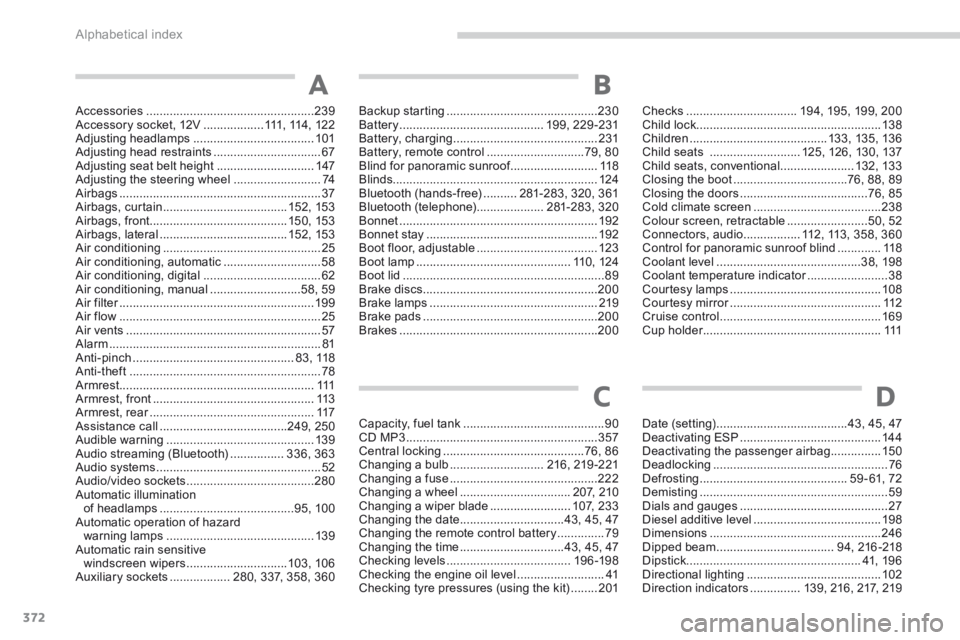
Alphabetical index
372
Accessories ..................................................239Accessory socket, 12V ..................111, 114 , 12 2Adjusting headlamps ....................................101Adjusting head restraints ................................67Adjusting seat belt height .............................147Adjusting the steering wheel ..........................74Airbags ............................................................37Airbags, curtain .....................................152, 153Airbags, front.........................................150, 153Airbags, lateral ......................................152, 153Air conditioning ...............................................25Air conditioning, automatic .............................58Air conditioning, digital ...................................62Air conditioning, manual ...........................58, 59Air filter ..........................................................Air filter ..........................................................Air filter19 9Air flow ............................................................25Air vents ..........................................................57Alarm ...............................................................81Anti-pinch ................................................8 3 , 118Anti-theft .........................................................78Armrest ..........................................................111Armrest, front ................................................113Armrest, rear .................................................Armrest, rear .................................................Armrest, rear117Assistance call ......................................249, 250Audible warning ............................................13 9Audio streaming (Bluetooth) ................336, 363Audio systems .................................................52Audio/video sockets ......................................280Automatic illumination of headlamps ........................................95, 100Automatic operation of hazard warning lamps ............................................13 9Automatic rain sensitive windscreen wipers ..............................103, 10 6Auxiliary sockets ..................280, 337, 358, 360
Backup starting .............................................230Battery ...........................................199, 229 -231Battery, charging ...........................................231Battery, remote control .............................79, 80Blind for panoramic sunroof ..........................Blind for panoramic sunroof ..........................Blind for panoramic sunroof118Blinds.............................................................124Bluetooth (hands-free) ..........281-283, 320, 361Bluetooth (telephone) ....................281-283, 320Bonnet ...........................................................192Bonnet stay ...................................................192Boot floor, adjustable ....................................123Boot lamp ..............................................11 0 , 12 4Boot lid ............................................................89Brake discs ....................................................200Brake lamps ..................................................219Brake pads ....................................................200Brakes ...........................................................200
A
Checks .................................194, 195, 199, 200Child lock .......................................................13 8Children .........................................13 3, 13 5, 13 6Child seats ...........................125, 126, 130, 137Child seats, conventional ......................132, 13 3Closing the boot ..................................76, 88, 89Closing the doors ......................................76, 85Cold climate screen ......................................238Colour screen, retractable ........................50, 52Connectors, audio .................112, 113, 358, 360Control for panoramic sunroof blind .............118Coolant level ...........................................38, 198Coolant temperature indicator ........................Coolant temperature indicator ........................Coolant temperature indicator38Courtesy lamps .............................................108Courtesy mirror .............................................Courtesy mirror .............................................Courtesy mirror112Cruise control ................................................169Cup holder .....................................................Cup holder .....................................................Cup holder111
Capacity, fuel tank ..........................................90CD MP3 .........................................................357Central locking ..........................................76, 86Changing a bulb ............................216, 219 -221Changing a fuse ............................................222Changing a wheel .................................2 0 7, 2 1 0Changing a wiper blade ........................1 0 7, 2 3 3Changing the date ...............................43, 45, 47Changing the remote control battery ..............79Changing the time ...............................43, 45, 47Checking levels .....................................19 6 -198Checking the engine oil level ..........................41Checking tyre pressures (using the kit) ........201
Date (setting) .......................................43, 45, 47Deactivating ESP ..........................................14 4Deactivating the passenger airbag ...............150Deadlocking ....................................................76Defrosting ............................................59 - 61, 72Demisting ........................................................59Dials and gauges ............................................27Diesel additive level ......................................198Dimensions ...................................................246Dipped beam ...................................94, 216 -218Dipstick ....................................................41, 196Directional lighting ........................................102Direction indicators ...............139, 216, 217, 219
CD
B
Page 389 of 389
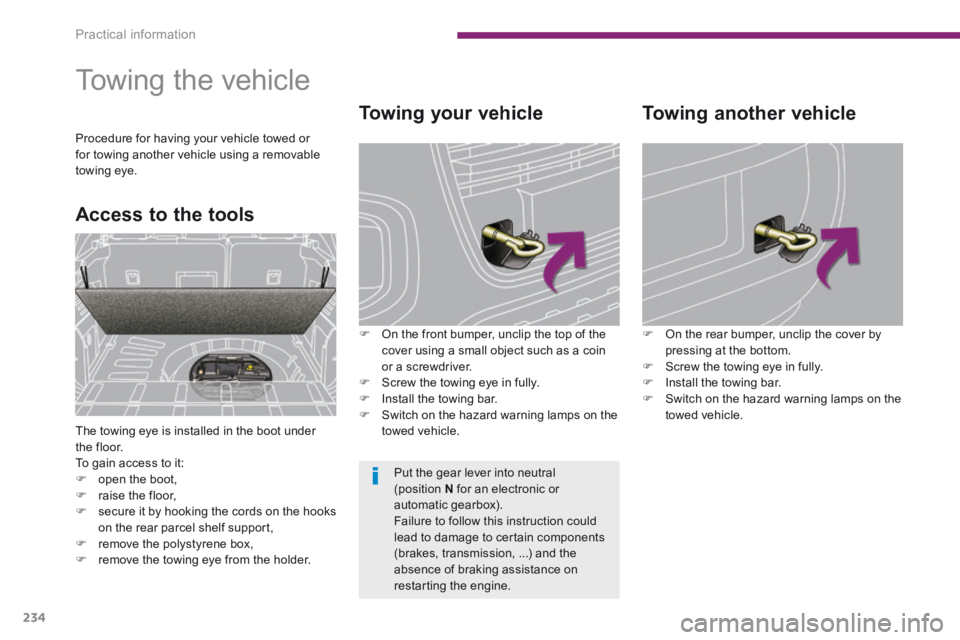
Practical information
234
Towing your vehicle
On the front bumper, unclip the top of the cover using a small object such as a coin or a screwdriver. Screw the towing eye in fully. Install the towing bar. Switch on the hazard warning lamps on the towed vehicle.
On the rear bumper, unclip the cover by pressing at the bottom. Screw the towing eye in fully. Install the towing bar. Switch on the hazard warning lamps on the towed vehicle.
Towing another vehicle
Put the gear lever into neutral (position N for an electronic or automatic gearbox). Failure to follow this instruction could lead to damage to certain components (brakes, transmission, ...) and the absence of braking assistance on restarting the engine.
Towing the vehicle
Access to the tools
The towing eye is installed in the boot under the floor. To gain access to it: open the boot, raise the floor, secure it by hooking the cords on the hooks on the rear parcel shelf support, remove the polystyrene box, remove the towing eye from the holder.
Procedure for having your vehicle towed or for towing another vehicle using a removable towing eye.